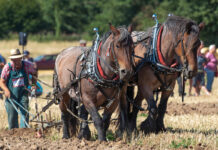
Learn about the Paint horse breed and how they came to be, leading to why they are the second most popular horse in the united states.
By the time primitive man became one of those predators, the markings we see on today’s Paint Horses came into being. More than 20,000 years ago, cave dwellers in Europe drew horses with Paint markings on rock walls.
Thousands of years later, Paint markings appeared on the tomb of Menna, a wealthy Egyptian landowner who lived in 1400 B.C. The horse pulling his chariot bears the markings we associate today with the Paint.
Horses so marked were valued not only in Africa, but also by the Eastern cultures of early China, Tibet and India. The Romans, centuries later, also treasured this colorful horse, using it in chariot races and other sports, as well as public ceremonies.
Through the Roman presence in the world, horses with these pinto markings—the Spanish word for “painted”—spread all over Europe. In Iberia, the pinto gene was present in the best Andalusian, Barb and Arabian horses. When the Spaniards set sail to explore new worlds, they took this blood with them.

American Paints
This is where the history of the Paint Horse breed in America begins. Spanish Conquistadors ventured to the New World, bringing some of their two-toned horses with them.
In 1519, according to the records of explorer Hernando Cortes, the first two pinto-marked horses set foot on American shores. They belonged to the men of Cortes’ expedition to Mexico. Cortes’ words suggest that one was a tobiano, the other an overo. Their arrival was just the beginning of what would be a flood of horses—a number of which had pinto markings—to American soil.
On the rancheros and missions of the Southwest, pinto-marked horses lived and worked alongside solid-colored equines. The Pueblo Indians, native farmers who had lived in peace for centuries, were pushed into submission by the Spaniards. Although the Spaniards decreed that the Pueblos should not be allowed to ride, the native peoples took to the horse right away. They raided the ranches and missions and brought the horses to their lands.
As the centuries passed and horses spread throughout the West, tribes from many parts of the country came to know the horse. In these Native American herds, there were many pintos.
By the mid-1800s, vast herds of longhorns had replaced buffalo throughout the West, and horses were needed to work the cattle. When Spanish-bred horses—including those with pinto markings—were asked to move cattle across the range, they obliged.
Many decades later, in the 1960s, a group of dedicated horsemen and horsewomen who appreciated the talent, athleticism and beautiful markings of these working cow horses started the American Paint Horse Association. To this day, the AHPA has registered more than 1 million Paint Horses in 59 countries and territories around the world.
Chrome Coats
Although the Paint Horse has many great qualities, the breed is most well-known for its markings. Tobianos are the most abundant colorations in the Paint breed, with most having white legs and bodies covered with well-formed splashes of color. The white usually covers the horses’ backs and extends over the withers, while the chest and hindquarters are often dark.
Overos are the next most common type of Paint, and have heads that are mostly white; some have blue eyes. Their chests are dark, as are their flanks and rumps. The belly is white and spreads up on the horse’s sides, but it rarely crosses over the back. Paints can be a combination of white and any other horse color, including bay, blue roan, brown, buckskin, chestnut, dun, gray, grullo, palomino, red dun, sorrel and red roan.
The Paint Horse is the second most popular breed in the U.S., and it’s easy to see why. Its combination of athleticism, intelligence and color make it hard to beat.
For more information, visit the American Paint Horse Association at www.apha.com.
AUDREY PAVIA is a freelance writer and the author of Horses for Dummies. She lives in Norco, Calif., with her two registered Spanish Mustangs, Milagro and Rio.
This article originally about the Paint horse breed appeared in the March 2018 issue of Horse Illustrated magazine. Click here to subscribe!





